SKODA ROOMSTER 2007 1.G Owner's Manual
Manufacturer: SKODA, Model Year: 2007, Model line: ROOMSTER, Model: SKODA ROOMSTER 2007 1.GPages: 248, PDF Size: 46.44 MB
Page 181 of 248
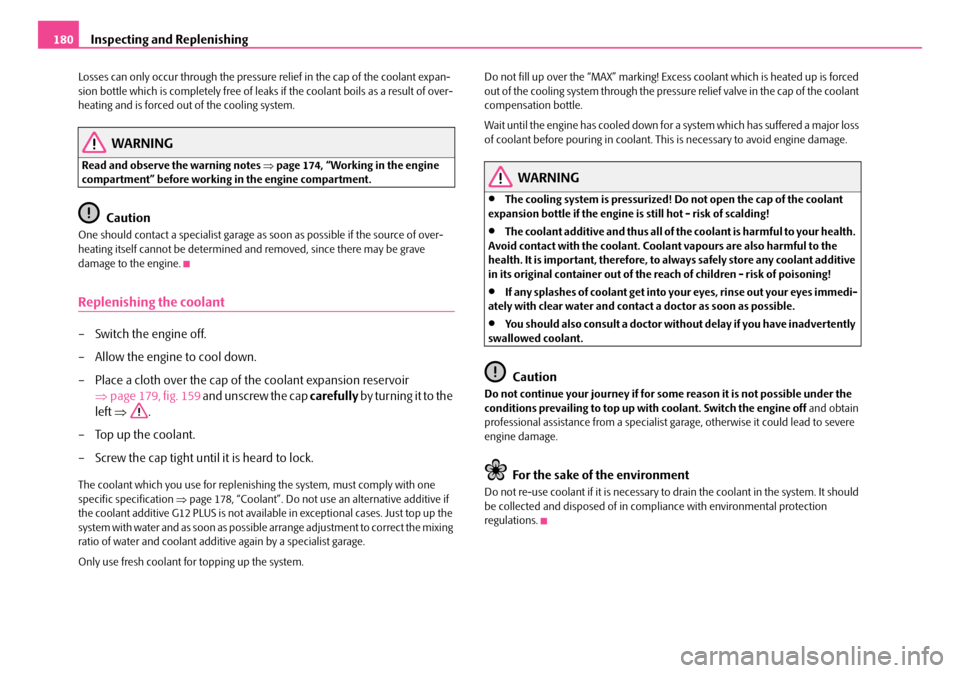
Inspecting and Replenishing180
Losses can only occur through the pressure relief in the cap of the coolant expan- sion bottle which is completely free of leak s if the coolant boils as a result of over- heating and is forced out of the cooling system.
WARNING
Read and observe the warning notes ⇒page 174, “Working in the engine compartment” before working in the engine compartment.
Caution
One should contact a specialist garage as soon as possible if the source of over- heating itself cannot be determined and removed, since there may be grave damage to the engine.
Replenishing the coolant
– Switch the engine off.
– Allow the engine to cool down.
– Place a cloth over the cap of the coolant expansion reservoir
⇒ page 179, fig. 159 and unscrew the cap carefully by turning it to the
left ⇒.
– Top up the coolant.
– Screw the cap tight until it is heard to lock.
The coolant which you use for replenishing the system, must comply with one specific specification ⇒page 178, “Coolant”. Do not use an alternative additive if the coolant additive G12 PLUS is not availa ble in exceptional cases. Just top up the system with water and as soon as possible arrange adjustment to correct the mixing ratio of water and coolant additive again by a specialist garage.
Only use fresh coolant for topping up the system.
Do not fill up over the “MAX” marking! Excess coolant which is heated up is forced out of the cooling system through the pressure relief valve in the cap of the coolant compensation bottle.
Wait until the engine has cooled down for a system which has suffered a major loss of coolant before pouring in coolant. This is necessary to avoid engine damage.
WARNING
•The cooling system is pressurized! Do not open the cap of the coolant expansion bottle if the engine is still hot - risk of scalding!
•The coolant additive and thus all of the coolant is harmful to your health. Avoid contact with the coolant. Coolant vapours are also harmful to the health. It is important, therefore, to always safely store any coolant additive in its original container out of the reach of children - risk of poisoning!
•If any splashes of coolant get into yo ur eyes, rinse out your eyes immedi- ately with clear water and contact a doctor as soon as possible.
•You should also consult a doctor without delay if you have inadvertently swallowed coolant.
Caution
Do not continue your journey if for some reason it is not possible under the conditions prevailing to top up with coolant. Switch the engine off and obtain professional assistance from a specialist garage, otherwise it could lead to severe engine damage.
For the sake of the environment
Do not re-use coolant if it is necessary to drain the coolant in the system. It should be collected and disposed of in comp liance with environmental protection regulations.
NKO A05R 20 MR08.book Page 180 Wednesday, March 28, 2007 9:42 AM
Page 182 of 248
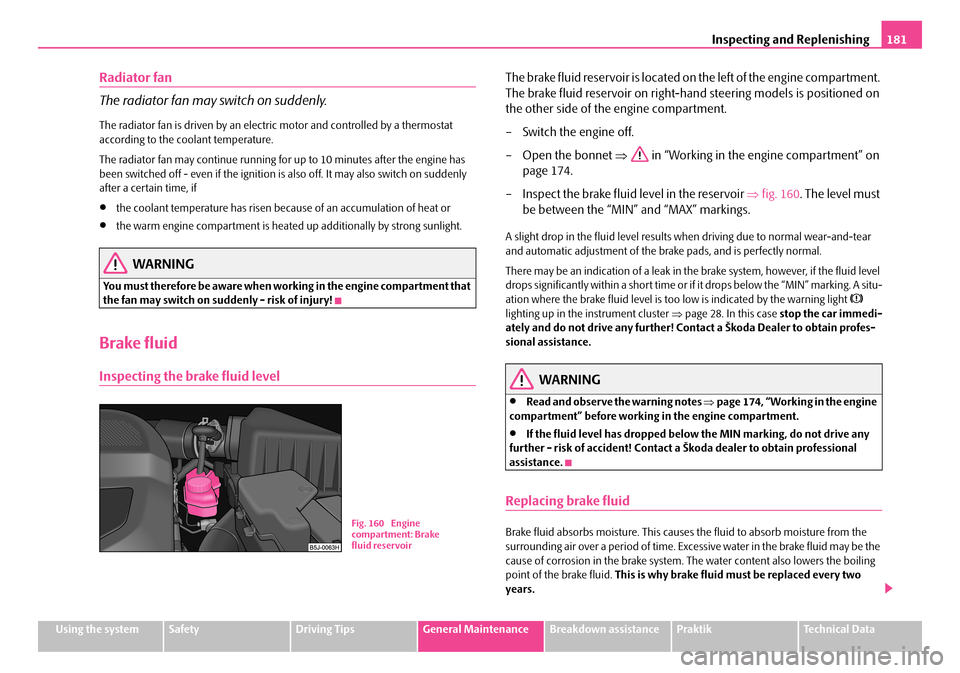
Inspecting and Replenishing181
Using the systemSafetyDriving TipsGeneral MaintenanceBreakdown assistancePraktikTechnical Data
Radiator fan
The radiator fan may switch on suddenly.
The radiator fan is driven by an electric motor and controlled by a thermostat according to the coolant temperature.
The radiator fan may continue running fo r up to 10 minutes after the engine has been switched off - even if the ignition is also off. It may also switch on suddenly after a certain time, if
•the coolant temperature ha s risen because of an accumulation of heat or
•the warm engine compartment is heated up additionally by strong sunlight.
WARNING
You must therefore be aware when working in the engine compartment that the fan may switch on suddenly - risk of injury!
Brake fluid
Inspecting the brake fluid level
The brake fluid reservoir is located on the left of the engine compartment.
The brake fluid reservoir on right-hand steering models is positioned on
the other side of the engine compartment.
– Switch the engine off.
– Open the bonnet ⇒ in “Working in the engine compartment” on
page 174.
– Inspect the brake fluid level in the reservoir ⇒fig. 160. The level must
be between the “MIN” and “MAX” markings.
A slight drop in the fluid level results when driving due to normal wear-and-tear and automatic adjustment of the br ake pads, and is perfectly normal.
There may be an indication of a leak in the brake system, however, if the fluid level drops significantly within a short time or if it drops below the “MIN” marking. A situ-ation where the brake fluid level is too low is indicated by the warning light lighting up in the instrument cluster ⇒page 28. In this case stop the car immedi- ately and do not drive any further! Cont act a Škoda Dealer to obtain profes- sional assistance.
WARNING
•Read and observe the warning notes ⇒page 174, “Working in the engine compartment” before working in the engine compartment.
•If the fluid level has dropped below the MIN marking, do not drive any further - risk of accident! Contact a Škoda dealer to obtain professional assistance.
Replacing brake fluid
Brake fluid absorbs moisture. This causes the fluid to absorb moisture from the surrounding air over a period of time. Excessive water in the brake fluid may be the cause of corrosion in the brake system. Th e water content also lowers the boiling point of the brake fluid. This is why brake fluid must be replaced every two years.
Fig. 160 Engine compartment: Brake fluid reservoir
NKO A05R 20 MR08.book Page 181 Wednesday, March 28, 2007 9:42 AM
Page 183 of 248
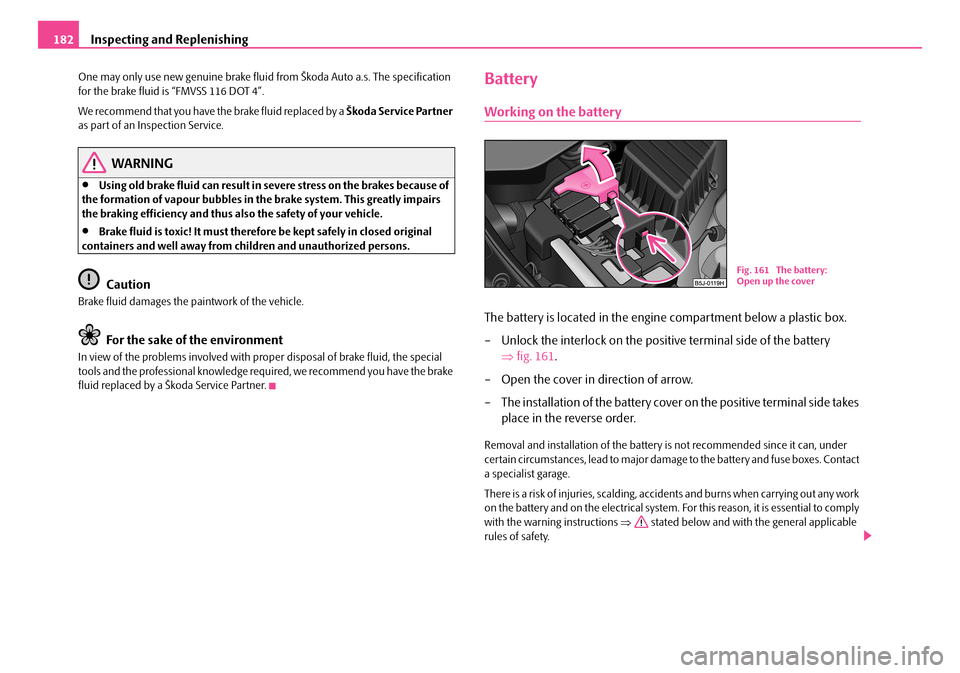
Inspecting and Replenishing182
One may only use new genuine brake fluid from Škoda Auto a.s. The specification for the brake fluid is “FMVSS 116 DOT 4”.
We recommend that you have the brake fluid replaced by a Škoda Service Partner as part of an Inspection Service.
WARNING
•Using old brake fluid can result in seve re stress on the brakes because of the formation of vapour bubbles in the brake system. This greatly impairs the braking efficiency and thus also the safety of your vehicle.
•Brake fluid is toxic! It must therefore be kept safely in closed original containers and well aw ay from children and unauthorized persons.
Caution
Brake fluid damages the paintwork of the vehicle.
For the sake of the environment
In view of the problems involved with proper disposal of brake fluid, the special tools and the professional knowledge required, we recommend you have the brake fluid replaced by a Škoda Service Partner.
Battery
Working on the battery
The battery is located in the engine compartment below a plastic box.
– Unlock the interlock on the positive terminal side of the battery
⇒ fig. 161.
– Open the cover in direction of arrow.
– The installation of the battery cover on the positive terminal side takes
place in the reverse order.
Removal and installation of the battery is not recommended since it can, under certain circumstances, lead to major damage to the battery and fuse boxes. Contact a specialist garage.
There is a risk of injuries, scalding, acci dents and burns when carrying out any work on the battery and on the electrical system. For this reason, it is essential to comply with the warning instructions ⇒ stated below and with the general applicable rules of safety.
Fig. 161 The battery: Open up the cover
NKO A05R 20 MR08.book Page 182 Wednesday, March 28, 2007 9:42 AM
Page 184 of 248
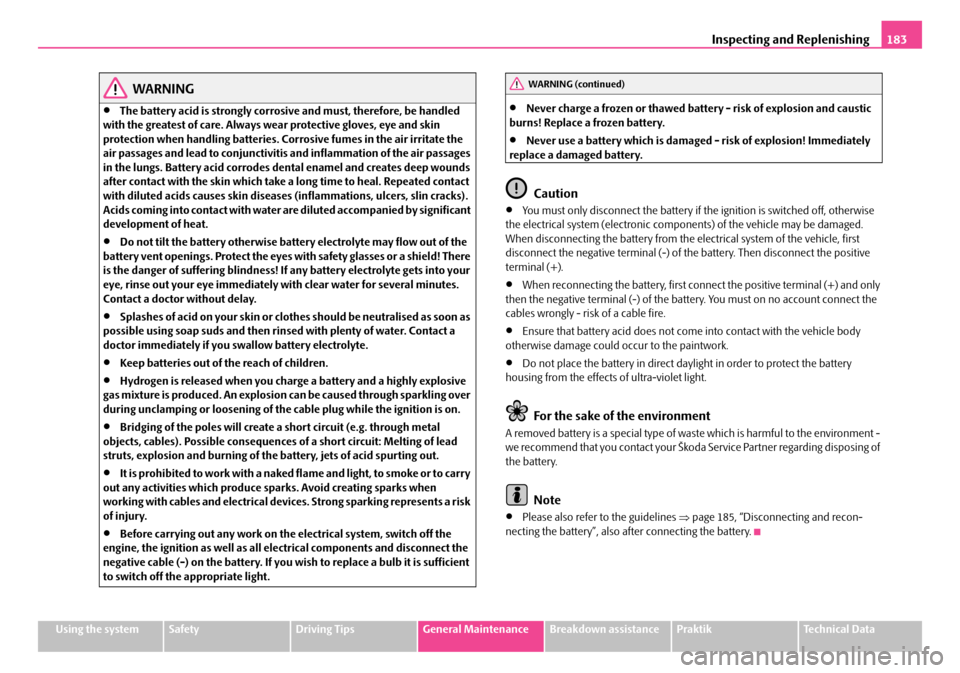
Inspecting and Replenishing183
Using the systemSafetyDriving TipsGeneral MaintenanceBreakdown assistancePraktikTechnical Data
WARNING
•The battery acid is strongly corrosive and must, therefore, be handled with the greatest of care. Always we ar protective gloves, eye and skin protection when handling batteries. Corrosive fumes in the air irritate the air passages and lead to conjunctivitis and inflammation of the air passages in the lungs. Battery acid corrodes dental enamel and creates deep wounds after contact with the skin which take a long time to heal. Repeated contact with diluted acids causes skin diseases (inflammations, ulcers, slin cracks). Acids coming into contact with water are diluted accompanied by significant development of heat.
•Do not tilt the battery otherwise battery electrolyte may flow out of the battery vent openings. Prot ect the eyes with safety glasses or a shield! There is the danger of suffering blindness! If any battery electrolyte gets into your eye, rinse out your eye immediately with clear water for several minutes. Contact a doctor without delay.
•Splashes of acid on your skin or clothes should be neutralised as soon as possible using soap suds and then rinsed with plenty of water. Contact a doctor immediately if you swallow battery electrolyte.
•Keep batteries out of the reach of children.
•Hydrogen is released when you char ge a battery and a highly explosive gas mixture is produced. An explosion can be caused through sparkling over during unclamping or loosening of the cable plug while the ignition is on.
•Bridging of the poles will create a short circuit (e.g. through metal objects, cables). Possible consequences of a short circuit: Melting of lead struts, explosion and burning of the battery, jets of acid spurting out.
•It is prohibited to work with a naked flame and light, to smoke or to carry out any activities which produce sparks. Avoid creating sparks when working with cables and electrical device s. Strong sparking represents a risk of injury.
•Before carrying out any work on the electrical system, switch off the engine, the ignition as well as all electrical components and disconnect the negative cable (-) on the battery. If you wish to replace a bulb it is sufficient to switch off the appropriate light.
•Never charge a frozen or thawed battery - risk of explosion and caustic burns! Replace a frozen battery.
•Never use a battery which is damaged - risk of explosion! Immediately replace a damaged battery.
Caution
•You must only disconnect the battery if the ignition is switched off, otherwise the electrical system (electronic components) of the vehicle may be damaged. When disconnecting the battery from the el ectrical system of the vehicle, first disconnect the negative terminal (-) of th e battery. Then disconnect the positive terminal (+).
•When reconnecting the battery, first conne ct the positive terminal (+) and only then the negative terminal (-) of the batt ery. You must on no account connect the cables wrongly - risk of a cable fire.
•Ensure that battery acid does not come into contact with the vehicle body otherwise damage could occur to the paintwork.
•Do not place the battery in direct daylight in order to protect the battery housing from the effects of ultra-violet light.
For the sake of the environment
A removed battery is a special type of waste which is harmful to the environment - we recommend that you contact your Škod a Service Partner regarding disposing of the battery.
Note
•Please also refer to the guidelines ⇒page 185, “Disconnecting and recon- necting the battery”, also after connecting the battery.
WARNING (continued)
NKO A05R 20 MR08.book Page 183 Wednesday, March 28, 2007 9:42 AM
Page 185 of 248
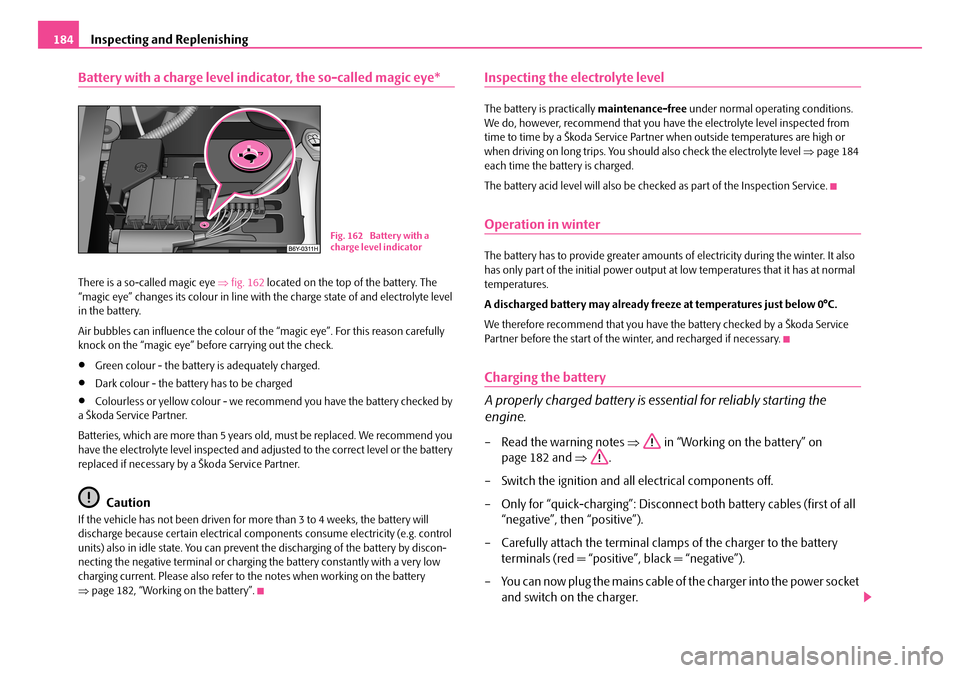
Inspecting and Replenishing184
Battery with a charge level indicator, the so-called magic eye*
There is a so-called magic eye ⇒fig. 162 located on the top of the battery. The “magic eye” changes its colour in line with the charge state of and electrolyte level in the battery.
Air bubbles can influence the colour of th e “magic eye”. For this reason carefully knock on the “magic eye” before carrying out the check.
•Green colour - the battery is adequately charged.
•Dark colour - the battery has to be charged
•Colourless or yellow colour - we reco mmend you have the battery checked by a Škoda Service Partner.
Batteries, which are more than 5 years old, must be replaced. We recommend you have the electrolyte level inspected and adjusted to the correct level or the battery replaced if necessary by a Škoda Service Partner.
Caution
If the vehicle has not been driven for more than 3 to 4 weeks, the battery will discharge because certain electrical comp onents consume electricity (e.g. control units) also in idle state. You can prevent the discharging of the battery by discon- necting the negative terminal or charging the battery constantly with a very low charging current. Please also refer to the notes when working on the battery ⇒ page 182, “Working on the battery”.
Inspecting the electrolyte level
The battery is practically maintenance-free under normal operating conditions. We do, however, recommend that you have the electrolyte level inspected from time to time by a Škoda Service Partner when outside temperatures are high or when driving on long trips. You should also check the electrolyte level ⇒page 184 each time the battery is charged.
The battery acid level will also be ch ecked as part of the Inspection Service.
Operation in winter
The battery has to provide greater amounts of electricity during the winter. It also has only part of the initial power output at low temperatures that it has at normal temperatures.
A discharged battery may already freez e at temperatures just below 0°C.
We therefore recommend that you have the battery checked by a Škoda Service Partner before the start of the winter, and recharged if necessary.
Charging the battery
A properly charged battery is essential for reliably starting the
engine.
– Read the warning notes ⇒ in “Working on the battery” on
page 182 and ⇒.
– Switch the ignition and all electrical components off.
– Only for “quick-charging” : Disconnect both battery cables (first of all
“negative”, then “positive”).
– Carefully attach the terminal clam ps of the charger to the battery
terminals (red = “positive”, black = “negative”).
– You can now plug the mains cable of the charger into the power socket
and switch on the charger.
Fig. 162 Battery with a charge level indicator
NKO A05R 20 MR08.book Page 184 Wednesday, March 28, 2007 9:42 AM
Page 186 of 248
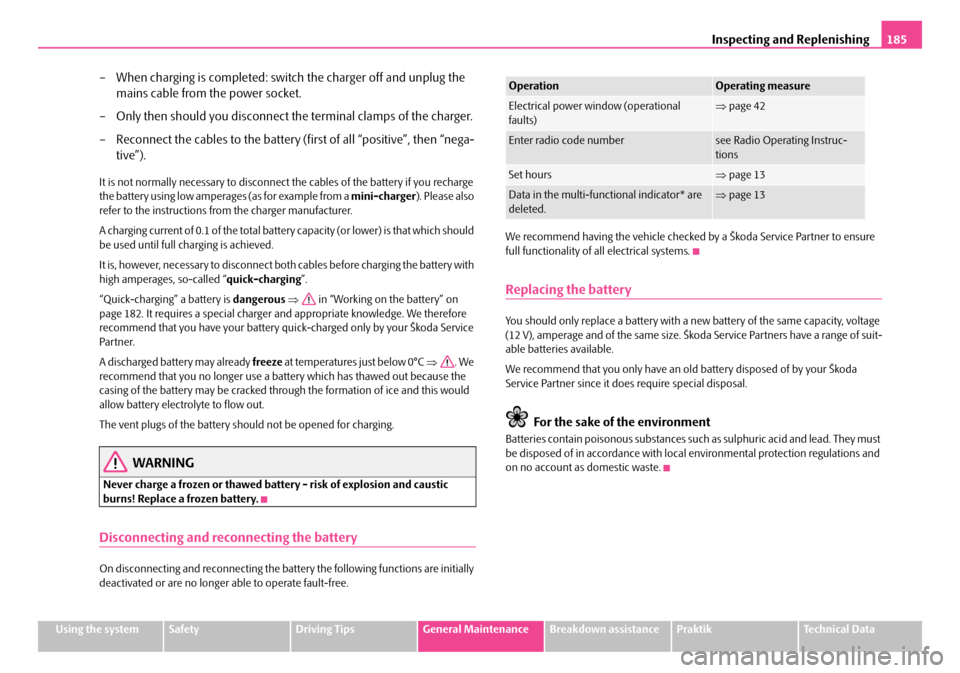
Inspecting and Replenishing185
Using the systemSafetyDriving TipsGeneral MaintenanceBreakdown assistancePraktikTechnical Data
– When charging is completed: switch the charger off and unplug the
mains cable from the power socket.
– Only then should you disconnect the terminal clamps of the charger.
– Reconnect the cables to the battery (first of all “positive”, then “nega-
tive”).
It is not normally necessary to disconnect the cables of the battery if you recharge the battery using low ampera ges (as for example from a mini-charger). Please also refer to the instructions from the charger manufacturer.
A charging current of 0.1 of the total batter y capacity (or lower) is that which should be used until full charging is achieved.
It is, however, necessary to disconnect both cables before charging the battery with high amperages, so-called “ quick-charging”.
“Quick-charging” a battery is dangerous ⇒ in “Working on the battery” on page 182. It requires a special charger an d appropriate knowledge. We therefore recommend that you have your battery qu ick-charged only by your Škoda Service Par tner.
A discharged battery may already freeze at temperatures just below 0°C ⇒. We recommend that you no longer use a ba ttery which has thawed out because the casing of the battery may be cracked through the formation of ice and this would allow battery electrolyte to flow out.
The vent plugs of the battery should not be opened for charging.
WARNING
Never charge a frozen or thawed battery - risk of explosion and caustic burns! Replace a frozen battery.
Disconnecting and reconnecting the battery
On disconnecting and reconnecting the batte ry the following functions are initially deactivated or are no longer able to operate fault-free.
We recommend having the vehicle checked by a Škoda Service Partner to ensure full functionality of all electrical systems.
Replacing the battery
You should only replace a battery with a new battery of the same capacity, voltage (12 V), amperage and of the same size. Škoda Service Partners have a range of suit-able batteries available.
We recommend that you only have an ol d battery disposed of by your Škoda Service Partner since it does require special disposal.
For the sake of the environment
Batteries contain pois onous substances such as sulphuric acid and lead. They must be disposed of in accordance with loca l environmental protection regulations and on no account as domestic waste.
OperationOperating measure
Electrical power window (operational faults)⇒ page 42
Enter radio code numbersee Radio Operating Instruc- tions
Set hours⇒ page 13
Data in the multi-functional indicator* are deleted.⇒ page 13
NKO A05R 20 MR08.book Page 185 Wednesday, March 28, 2007 9:42 AM
Page 187 of 248
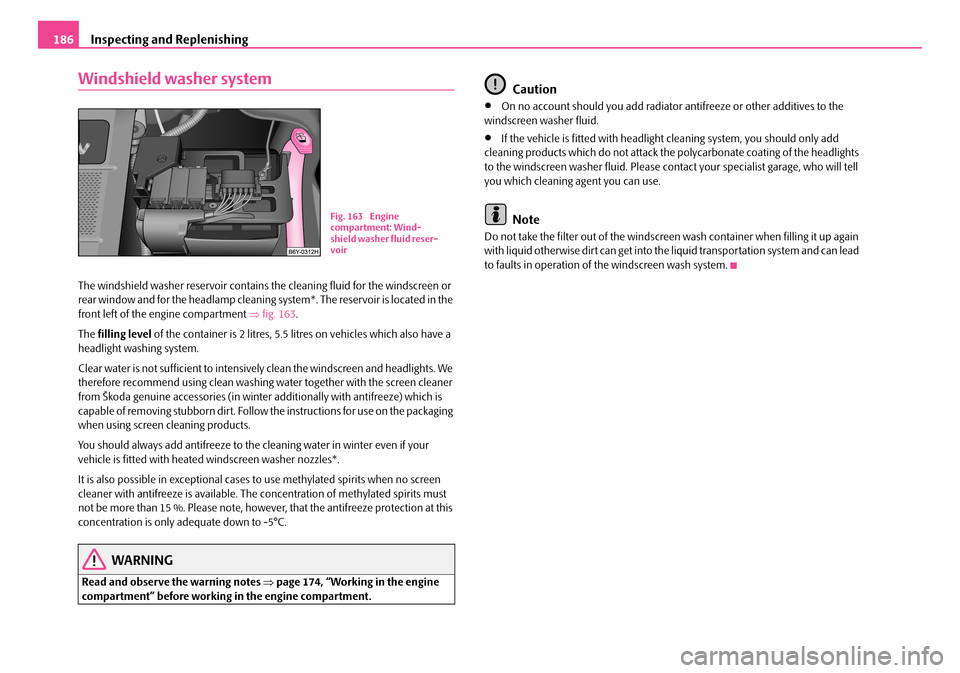
Inspecting and Replenishing186
Windshield washer system
The windshield washer reservoir contains the cleaning fluid for the windscreen or rear window and for the headlamp cleaning system*. The reservoir is located in the front left of the engine compartment ⇒fig. 163.
The filling level of the container is 2 litres, 5.5 litres on vehicles which also have a headlight washing system.
Clear water is not sufficient to intensivel y clean the windscreen and headlights. We therefore recommend using clean washing wa ter together with the screen cleaner from Škoda genuine accessorie s (in winter additionally with antifreeze) which is capable of removing stubborn dirt. Follow the instructions for use on the packaging when using screen cleaning products.
You should always add antifreeze to the cleaning water in winter even if your vehicle is fitted with heated windscreen washer nozzles*.
It is also possible in exceptional cases to use methylated spirits when no screen cleaner with antifreeze is available. The concentration of methylated spirits must not be more than 15 %. Please note, howeve r, that the antifreeze protection at this concentration is only adequate down to -5°C.
WARNING
Read and observe the warning notes ⇒page 174, “Working in the engine compartment” before working in the engine compartment.
Caution
•On no account should you add radiator antifreeze or other additives to the windscreen washer fluid.
•If the vehicle is fitted with headlight cleaning system, you should only add cleaning products which do not attack th e polycarbonate coating of the headlights to the windscreen washer fluid. Please contact your specialist garage, who will tell you which cleaning agent you can use.
Note
Do not take the filter out of the windscreen wash container when filling it up again with liquid otherwise dirt can get into the liquid transportation system and can lead to faults in operation of the windscreen wash system.
Fig. 163 Engine compartment: Wind-shield washer fluid reser-voir
NKO A05R 20 MR08.book Page 186 Wednesday, March 28, 2007 9:42 AM
Page 188 of 248
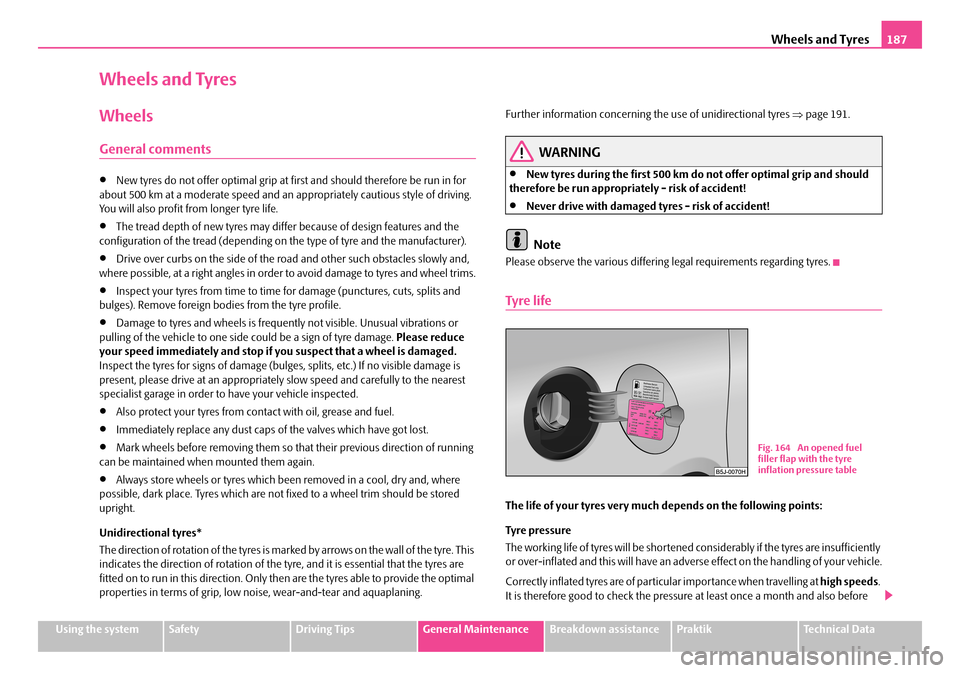
Wheels and Tyres187
Using the systemSafetyDriving TipsGeneral MaintenanceBreakdown assistancePraktikTechnical Data
Wheels and Tyres
Wheels
General comments
•New tyres do not offer optimal grip at first and should therefore be run in for about 500 km at a moderate speed and an appropriately cautious style of driving. You will also profit from longer tyre life.
•The tread depth of new tyres may differ because of design features and the configuration of the tread (depending on the type of tyre and the manufacturer).
•Drive over curbs on the side of the road and other such obstacles slowly and, where possible, at a right angles in order to avoid damage to tyres and wheel trims.
•Inspect your tyres from time to time for damage (punctures, cuts, splits and bulges). Remove foreign bodies from the tyre profile.
•Damage to tyres and wheels is frequent ly not visible. Unusual vibrations or pulling of the vehicle to one side could be a sign of tyre damage. Please reduce your speed immediately and stop if you suspect that a wheel is damaged. Inspect the tyres for signs of damage (bulge s, splits, etc.) If no visible damage is present, please drive at an appropriatel y slow speed and carefully to the nearest specialist garage in order to have your vehicle inspected.
•Also protect your tyres from contact with oil, grease and fuel.
•Immediately replace any dust caps of the valves which have got lost.
•Mark wheels before removing them so th at their previous direction of running can be maintained when mounted them again.
•Always store wheels or tyres which been removed in a cool, dry and, where possible, dark place. Tyres which are not fixed to a wheel trim should be stored upright.
Unidirectional tyres*
The direction of rotation of the tyres is marked by arrows on the wall of the tyre. This indicates the direction of rotation of the tyre, and it is essential that the tyres are fitted on to run in this direction. Only then are the tyres able to provide the optimal properties in terms of grip, low noise, wear-and-tear and aquaplaning.
Further information concerning the use of unidirectional tyres ⇒page 191.
WARNING
•New tyres during the first 500 km do not offer optimal grip and should therefore be run appropriately - risk of accident!
•Never drive with damaged tyres - risk of accident!
Note
Please observe the various differing legal requirements regarding tyres.
Tyre life
The life of your tyres very much depends on the following points:
Tyre pressure
The working life of tyres will be shortened considerably if the tyres are insufficiently or over-inflated and this will have an adverse effect on the handling of your vehicle.
Correctly inflated tyres are of partic ular importance when travelling at high speeds. It is therefore good to check the pressure at least once a month and also before
Fig. 164 An opened fuel filler flap with the tyre inflation pressure table
NKO A05R 20 MR08.book Page 187 Wednesday, March 28, 2007 9:42 AM
Page 189 of 248
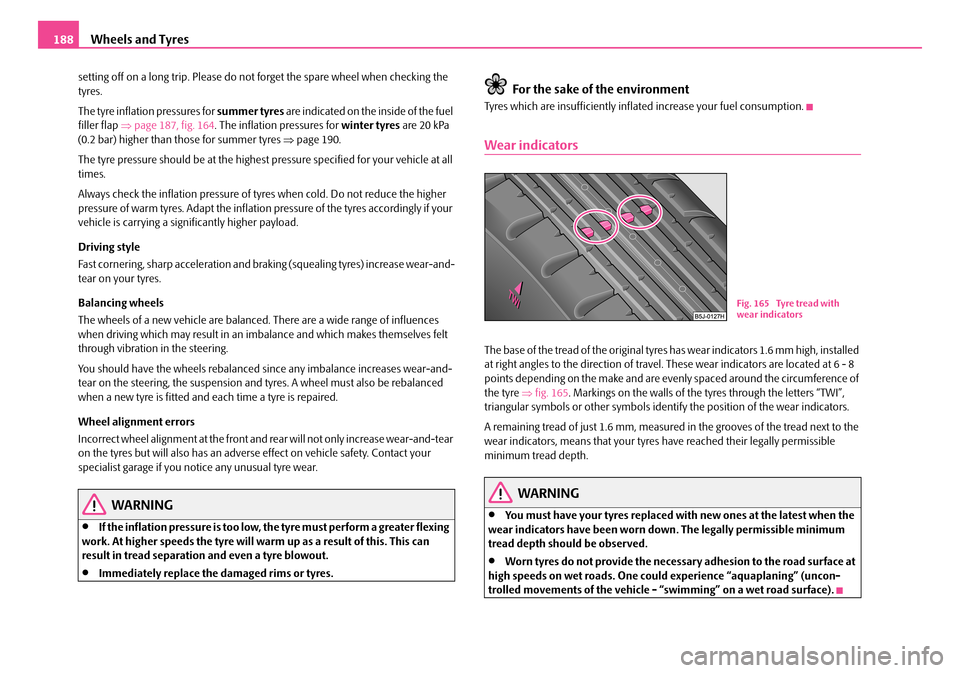
Wheels and Tyres188
setting off on a long trip. Please do not forget the spare wheel when checking the tyres.
The tyre inflation pressures for summer tyres are indicated on the inside of the fuel filler flap ⇒page 187, fig. 164. The inflation pressures for winter tyres are 20 kPa (0.2 bar) higher than those for summer tyres ⇒page 190.
The tyre pressure should be at the highest pressure specified for your vehicle at all times.
Always check the inflation pressure of ty res when cold. Do not reduce the higher pressure of warm tyres. Adapt the inflation pressure of the tyres accordingly if your vehicle is carrying a significantly higher payload.
Driving style
Fast cornering, sharp acceleration and braking (squealing tyres) increase wear-and- tear on your tyres.
Balancing wheels
The wheels of a new vehicle are balanced. There are a wide range of influences when driving which may result in an imbalance and which makes themselves felt through vibration in the steering.
You should have the wheels rebalanced since any imbalance increases wear-and- tear on the steering, the suspension and tyres. A wheel must also be rebalanced when a new tyre is fitted and each time a tyre is repaired.
Wheel alignment errors
Incorrect wheel alignment at the front and re ar will not only increase wear-and-tear on the tyres but will also has an adverse effect on vehicle safety. Contact your specialist garage if you notice any unusual tyre wear.
WARNING
•If the inflation pressure is too low, the tyre must perform a greater flexing work. At higher speeds the tyre will warm up as a result of this. This can result in tread separation and even a tyre blowout.
•Immediately replace the damaged rims or tyres.
For the sake of the environment
Tyres which are insufficiently inflated increase your fuel consumption.
Wear indicators
The base of the tread of the original tyres has wear indicators 1.6 mm high, installed at right angles to the direction of travel. These wear indicators are located at 6 - 8 points depending on the make and are evenly spaced around the circumference of the tyre ⇒fig. 165. Markings on the walls of the tyres through the letters “TWI”, triangular symbols or other symbols identi fy the position of the wear indicators.
A remaining tread of just 1.6 mm, measured in the grooves of the tread next to the wear indicators, means that your tyres have reached their legally permissible minimum tread depth.
WARNING
•You must have your tyres replaced with new ones at the latest when the wear indicators have been worn do wn. The legally permissible minimum tread depth should be observed.
•Worn tyres do not provide the necessary adhesion to the road surface at high speeds on wet roads. One coul d experience “aquaplaning” (uncon- trolled movements of the vehicle - “swimming” on a wet road surface).
Fig. 165 Tyre tread with wear indicators
NKO A05R 20 MR08.book Page 188 Wednesday, March 28, 2007 9:42 AM
Page 190 of 248
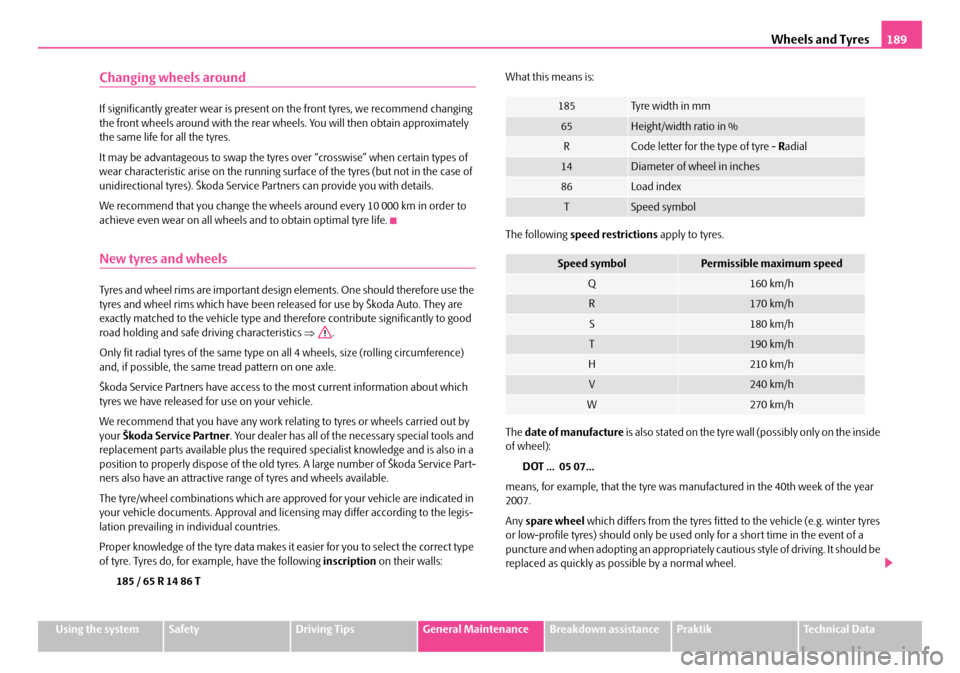
Wheels and Tyres189
Using the systemSafetyDriving TipsGeneral MaintenanceBreakdown assistancePraktikTechnical Data
Changing wheels around
If significantly greater wear is present on the front tyres, we recommend changing the front wheels around with the rear wheels. You will then obtain approximately the same life for all the tyres.
It may be advantageous to swap the tyre s over “crosswise” when certain types of wear characteristic ar ise on the running surface of the tyres (but not in the case of unidirectional tyres). Škoda Service Pa rtners can provide you with details.
We recommend that you change the wheels around every 10 000 km in order to achieve even wear on all wheels and to obtain optimal tyre life.
New tyres and wheels
Tyres and wheel rims are important design elements. One should therefore use the tyres and wheel rims which have been released for use by Škoda Auto. They are exactly matched to the vehicle type and th erefore contribute significantly to good road holding and safe driving characteristics ⇒.
Only fit radial tyres of the same type on all 4 wheels, size (rolling circumference) and, if possible, the same tread pattern on one axle.
Škoda Service Partners have access to the most current information about which tyres we have released for use on your vehicle.
We recommend that you have any work rela ting to tyres or wheels carried out by your Škoda Service Partner. Your dealer has all of the necessary special tools and replacement parts available plus the requir ed specialist knowledge and is also in a position to properly dispose of the old ty res. A large number of Škoda Service Part- ners also have an attractive range of tyres and wheels available.
The tyre/wheel combinations which are appr oved for your vehicle are indicated in your vehicle documents. Approval and lice nsing may differ according to the legis- lation prevailing in individual countries.
Proper knowledge of the tyre data makes it easier for you to select the correct type of tyre. Tyres do, for example, have the following inscription on their walls:
185 / 65 R 14 86 T
What this means is:
The following speed restrictions apply to tyres.
The date of manufacture is also stated on the tyre wall (possibly only on the inside of wheel):
DOT ... 05 07...
means, for example, that the tyre was manufactured in the 40th week of the year 2007.
Any spare wheel which differs from the tyres fitted to the vehicle (e.g. winter tyres or low-profile tyres) should only be used only for a short time in the event of a puncture and when adopting an appropriately cautious style of driving. It should be replaced as quickly as po ssible by a normal wheel.
185Ty re w i d t h i n m m
65Height/width ratio in %
RCode letter for the type of tyre - Radial
14Diameter of wheel in inches
86Load index
TSpeed symbol
Speed symbolPermissible maximum speed
Q160 km/h
R170 km/h
S180 km/h
T190 km/h
H210 km/h
V240 km/h
W270 km/h
NKO A05R 20 MR08.book Page 189 Wednesday, March 28, 2007 9:42 AM